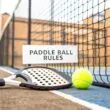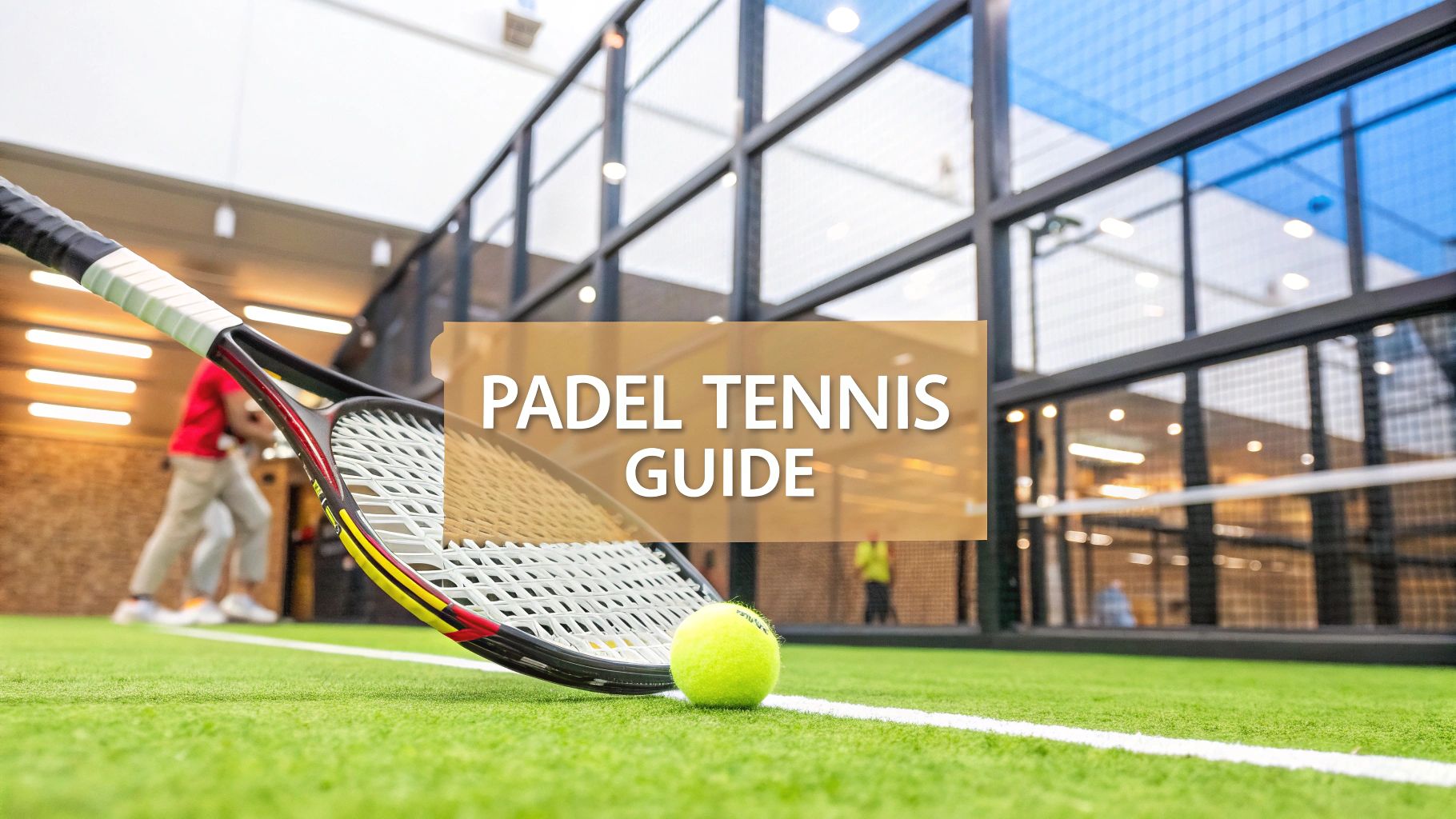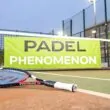Ever found yourself watching a game that looks like a mash-up of tennis and squash, played in a glass box with tons of energy and laughter? That’s padel tennis. It's one of those brilliant sports that’s incredibly easy to pick up but has enough depth to keep you hooked for years, making it a perfect fit for just about any age or fitness level.
Unpacking the Global Padel Phenomenon
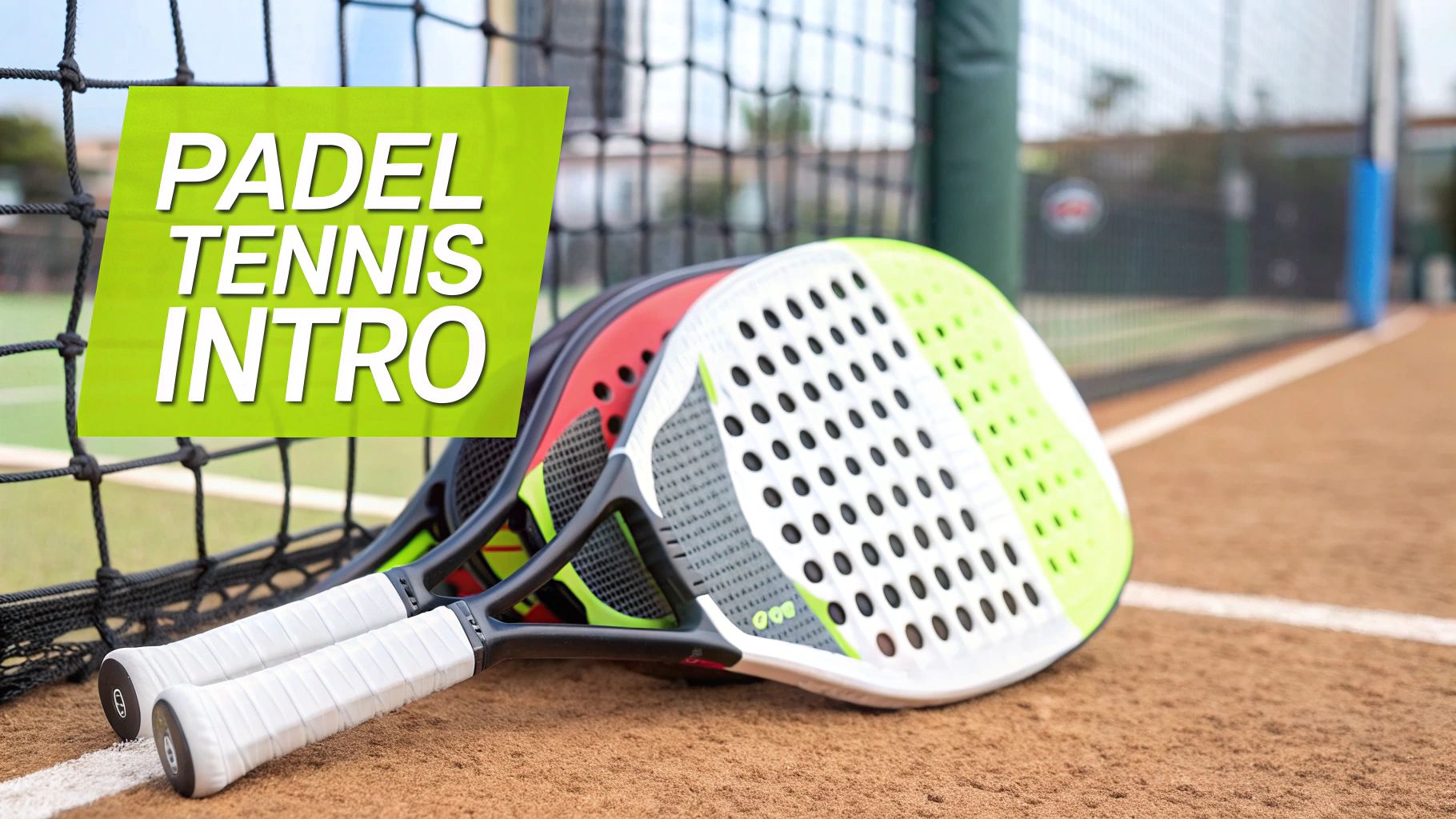
Padel has absolutely exploded in recent years, quickly shifting from a little-known pastime to a genuine global sensation. So, what’s the secret sauce behind its meteoric rise? It really boils down to how simple and social it is. Unlike tennis, which can feel intimidating for beginners, padel welcomes newcomers with open arms.
The court is smaller, the racket is a solid, stringless paddle, and the serve is always underhand. These aren't random rules; they're design choices that slow the game down just enough to encourage longer, more dynamic rallies from the get-go. You don’t need to sink months of practice just to have a fun, competitive match.

Buy the best padel gear to level up your next game!
CHECK OUT this deal from Padel Market!Get ready to take your game to the next level with the latest padel gear from Padel Market! Fast EU and Worldwide Shipping
This easy entry point makes padel a fantastic activity for families, friends, or even colleagues. Since it’s always played in doubles, the game is naturally built on communication and teamwork, creating a real sense of community on and off the court. You can dive deeper into its core concepts in our detailed guide on what padel is.
The Numbers Behind the Boom
The growth we're seeing isn't just a feeling; the statistics are truly staggering. The sport's expansion is one of the fastest in modern athletics. As of 2025, there are over 50,000 padel courts worldwide, and experts predict that number could rocket past 81,000 by 2027. This incredible momentum translates to a new padel club opening its doors somewhere in the world almost every two-and-a-half hours.
Data from a comprehensive global padel report from Playtomic backs this up, showing a year-on-year growth of 26% and a mind-blowing 385% jump in Google search interest over the last five years.
Padel’s magic lies in its balance. It combines the thrill of a high-energy workout with the strategic depth of a chess match, all while being an incredibly social experience.
To give you a clearer picture, let's break down the fundamental elements of the game.
Padel Tennis At a Glance
Here’s a quick summary of the key characteristics that define padel tennis.
| Characteristic | Description |
|---|---|
| Players | Almost always played in doubles (two players per team). |
| Court | A rectangular court (10m x 20m) enclosed by glass and mesh walls. |
| Racket | A solid, stringless racket called a 'pala', often made of foam and carbon fiber. |
| Ball | A low-compression ball, similar to a tennis ball but with less pressure. |
| Serve | Must be served underhand, making it easier for beginners to start a rally. |
| Wall Play | The walls are an integral part of the game; balls can be played off them. |
As you can see, these elements work together to create a sport that's both forgiving for beginners and full of strategic possibilities for seasoned players.
The Accidental Invention and Global Rise of Padel
Like all great sports, padel has an origin story. But this one doesn't start in a stuffy boardroom or a grand stadium. Instead, our story begins in the backyard of a Mexican businessman, Enrique Corcuera, in Acapulco, all the way back in 1969. Corcuera loved paddle tennis but had a problem: his backyard was small and hemmed in by walls.
Most people would see that as a limitation. Corcuera saw an opportunity. Instead of fighting the walls, he decided to make them part of the game. This one simple tweak gave birth to an entirely new sport. Suddenly, it wasn't just about raw power; it was about strategy, smarts, and using clever angles off the glass. The walls weren't just boundaries anymore—they were part of the action.
From Acapulco to the World
This quirky, addictive new game quickly caught the attention of Corcuera’s high-society friends, including Spanish royalty who visited him in Acapulco. One friend in particular, Prince Alfonso de Hohenlohe, was completely hooked. He loved it so much that he took the idea back home with him, building the very first two padel courts in Spain at the exclusive Marbella Club in 1974. This was the moment that lit the fuse for the padel explosion across Europe.
Around the same time, the sport traveled in another direction. An Argentine friend of Hohenlohe's brought padel to his home country, where it found a massive, passionate audience. In both Spain and Argentina, people fell in love with how social and easy it was to pick up. This grassroots energy cemented padel as a core part of their national sporting culture.
Padel’s history proves why it's so popular. It wasn't engineered for profit; it was born from a simple desire for fun and friendship. That's why it spread so naturally, from one friend to another, across the globe.
Making It Official
As padel’s popularity exploded, it became obvious that the sport needed some structure. So, in 1991, the International Padel Federation (FIP) was founded in Madrid. They created one official set of rules and a governing body to guide the sport's growth, turning it from a casual pastime into a legitimate international sport.
That growth has only picked up speed. Today, padel is played in at least 130 countries. The FIP itself has grown massively, counting 87 national federations by early 2025—an increase of 16 new members in just a short time. This framework is what supports everything from your local club to the biggest pro tournaments, as shown in recent data on padel's global acceleration.
The arrival of professional circuits, like the World Padel Tour (WPT), took things to another level. These tours brought the electric, fast-paced action of pro padel to a worldwide audience, inspiring millions to grab a 'pala' and get on the court themselves. From a cramped backyard in Acapulco to the global stage, padel's journey is a fantastic story of accidental genius that just keeps growing.
Understanding the Court and Your Equipment
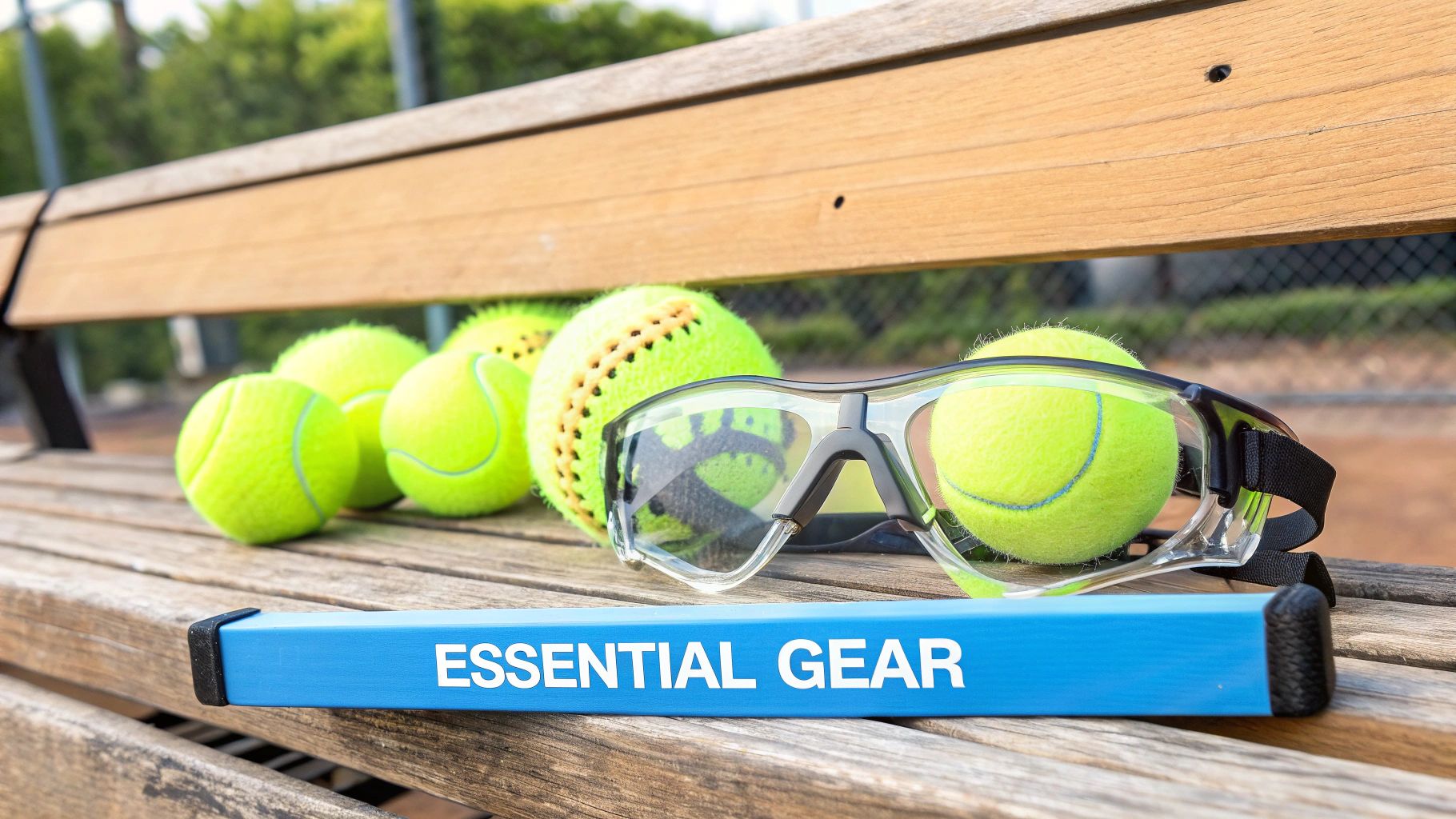

Buy the best padel gear to level up your next game!
CHECK OUT this deal from Padel Market!Get ready to take your game to the next level with the latest padel gear from Padel Market! Fast EU and Worldwide Shipping
Before you can truly get into the swing of padel, you have to get a feel for its unique environment and the tools of the trade. The court and equipment aren't just details; they are the very things that shape the game's strategy, pace, and incredible accessibility. They work together to create a sport that’s just as much about clever thinking as it is about athletic skill.
The magic really starts with the court itself. Don't think of it as just a playing surface—it's a dynamic arena. Measuring 10 meters wide by 20 meters long, a padel court is noticeably smaller than a tennis court. This immediately brings players closer together, fostering more social play and demanding faster reactions.
This cozy space is enclosed by a mix of glass walls and wire mesh fencing. But these walls aren't just boundaries; they're an active part of every single rally. A ball that hits the ground can then be played off the back or side glass, turning what would be a dead point in tennis into a brilliant strategic play. This single feature transforms padel into a fascinating game of angles and rebounds.
Choosing Your Padel Racket or Pala
Your main weapon in padel is the racket, which is simply called a 'pala'. Unlike a tennis racket with its familiar strings, a pala is a solid, stringless piece of equipment. It's perforated with holes to cut down on air resistance and weight, and it's typically built from materials like carbon fiber, fiberglass, and a foam core, giving it a very distinct pop and feel.
For anyone serious about their game, knowing the court's quirks and picking from the newest padel rackets is a game-changer. The pala's shape is the biggest factor in how it plays, and there are three main types to know:
- Round Shape: This is the go-to for beginners, and for good reason. The weight is balanced closer to the handle, which creates a large, forgiving sweet spot right in the middle. This design gives you maximum control, making it easier to place your shots even when your form isn't quite perfect.
- Teardrop Shape: The perfect middle ground. Teardrop palas offer a fantastic mix of power and control. Their sweet spot sits a bit higher than on a round racket, giving you more leverage for powerful shots without sacrificing too much accuracy. It's a favorite for intermediate players looking to step up their game.
- Diamond Shape: This is the racket for power hitters. The weight is concentrated toward the top of the pala, which helps you generate incredible force on smashes and aggressive volleys. The trade-off is a smaller sweet spot and less control, so it's best left to advanced players with solid technique.
The whole idea behind padel equipment is to create longer, more exciting rallies. The solid pala and lower-pressure ball slow the game down just enough to favor strategy over pure power, making it a blast for everyone.
The Padel Ball and Why It Matters
Finally, let's talk about the ball. It looks almost identical to a tennis ball, but a padel ball has slightly less internal pressure. This might sound like a tiny detail, but it massively impacts how the game is played.
Because it has lower pressure, the ball is less bouncy than a tennis ball. This subtle difference gives players that extra split second to get into position for their next shot. It stops rallies from ending too quickly with a single big hit and instead encourages those long, strategic exchanges that make the sport so addictive.
This intentional design choice is the final piece of the puzzle, working perfectly with the walled court and solid pala to create the unique experience of padel tennis. It guarantees that from your very first game, you'll be having fun, exciting rallies.
How to Play Padel: A Guide to Rules and Scoring
So, you're ready to jump on the court for your first game of padel? Fantastic. The rules are surprisingly simple and designed to get fun, flowing rallies going from the very first point. While it borrows the scoring system from tennis, padel’s unique twists—like the underhand serve and playing off the walls—make it an entirely different beast.
Let's break down exactly what you need to know to play with confidence.
Padel is almost always played in doubles, meaning two players per team. The objective is what you'd expect: hit the ball over the net so your opponents can't legally return it. You'll win a point if the ball bounces twice on their side, if they smack the ball into the net, or if they hit it out of the court before it bounces.
Mastering the Padel Serve
This is where the action starts, and the good news is, the padel serve is incredibly easy to pick up. Forget the powerful, overhead cannon serves you see in tennis. The padel serve is always hit underhand. This one rule is a game-changer, leveling the playing field and making it much simpler for beginners to get a rally started.
Here’s the simple breakdown of a legal serve:
- Stand Behind the Line: Both of your feet must be behind the service line.
- Bounce the Ball: You must bounce the ball on the ground once before making contact.
- Hit Below the Waist: When you strike the ball, it must be at or below your waist level.
- Serve Diagonally: The serve has to travel cross-court and land inside the opponent's service box.
If your first serve clips the net but still lands in the right box, it’s a "let," and you just replay the serve. If it hits the net and lands out, that’s a fault. Just like in tennis, you get two chances to get your serve in.
Understanding the Role of the Walls
The walls are what truly define padel and give it its strategic soul. They aren't just boundaries; they're an active part of the court you can—and should—use to your advantage. Learning to play off the glass can rescue a point you thought was lost and turn defense into a sneaky attack.
The most important rule to remember is this: the ball must always bounce on the ground first before it hits any wall. After the ball has bounced once on your side, you can let it rebound off one or more of the glass walls before you return it.
Think of the walls as your teammates. A ball that looks way out of reach might ricochet perfectly off the back glass, giving you the time you need to set up a killer return. This is the art of padel.
However, there are a couple of ways using the walls can go wrong:
- Directly into the Wall: If you hit the ball so it flies directly into an opponent's wall (glass or fence) before bouncing on the ground, you lose the point.
- Hitting the Wire Fence: After a legal bounce, you can play the ball off the glass walls. But if the ball hits the wire mesh fence before you return it, the point goes to your opponent.
Scoring a Game of Padel
If you’ve ever followed a tennis match, you’re already ahead of the game. Padel uses the exact same scoring system. It might seem a little quirky at first, but it quickly becomes second nature.
The points are called out like this:
- First point: 15
- Second point: 30
- Third point: 40
- Fourth point: Game
When both teams are tied at 40-40, it's called "deuce." To win the game from here, a team has to win two points in a row. Winning the first point after deuce gives you the "advantage." Win the next one, and the game is yours. If you lose it, the score snaps back to deuce. This back-and-forth can create some incredibly tense moments.
A set is won by the first team to win six games, but they must win by at least two games (like 6-4). If the score gets to 6-6, a tie-break is usually played to decide the set. Most official matches are the best of three sets.
Padel vs Tennis: Key Differences Explained
At first glance, you might think padel and tennis are practically the same sport. They both use a net, a ball, rackets, and that classic 15, 30, 40 scoring system we all know. But the moment you step onto a padel court, you’ll realize they are worlds apart.
Where tennis often hinges on raw power and individual athletic skill, padel is a game of strategy, patience, and clever placement. It’s less about brute force and more about out-thinking your opponent.
A New Arena: The Court and Racket
The biggest giveaway that you're not playing tennis anymore is the court itself. A padel court is much smaller (10m x 20m) and is completely enclosed by glass and mesh walls. These walls aren't just for show; they are an integral part of the game. You can play the ball off the glass, creating wild ricochets and opening up defensive possibilities you’d never see in tennis.
Then there’s the equipment. Tennis players wield large, strung rackets designed to generate blistering power and spin. In padel, you use a solid, stringless racket called a 'pala.' This perforated paddle gives you way more control, making it easier to place your shots with precision. It’s a tool built for finesse, not for overpowering serves.
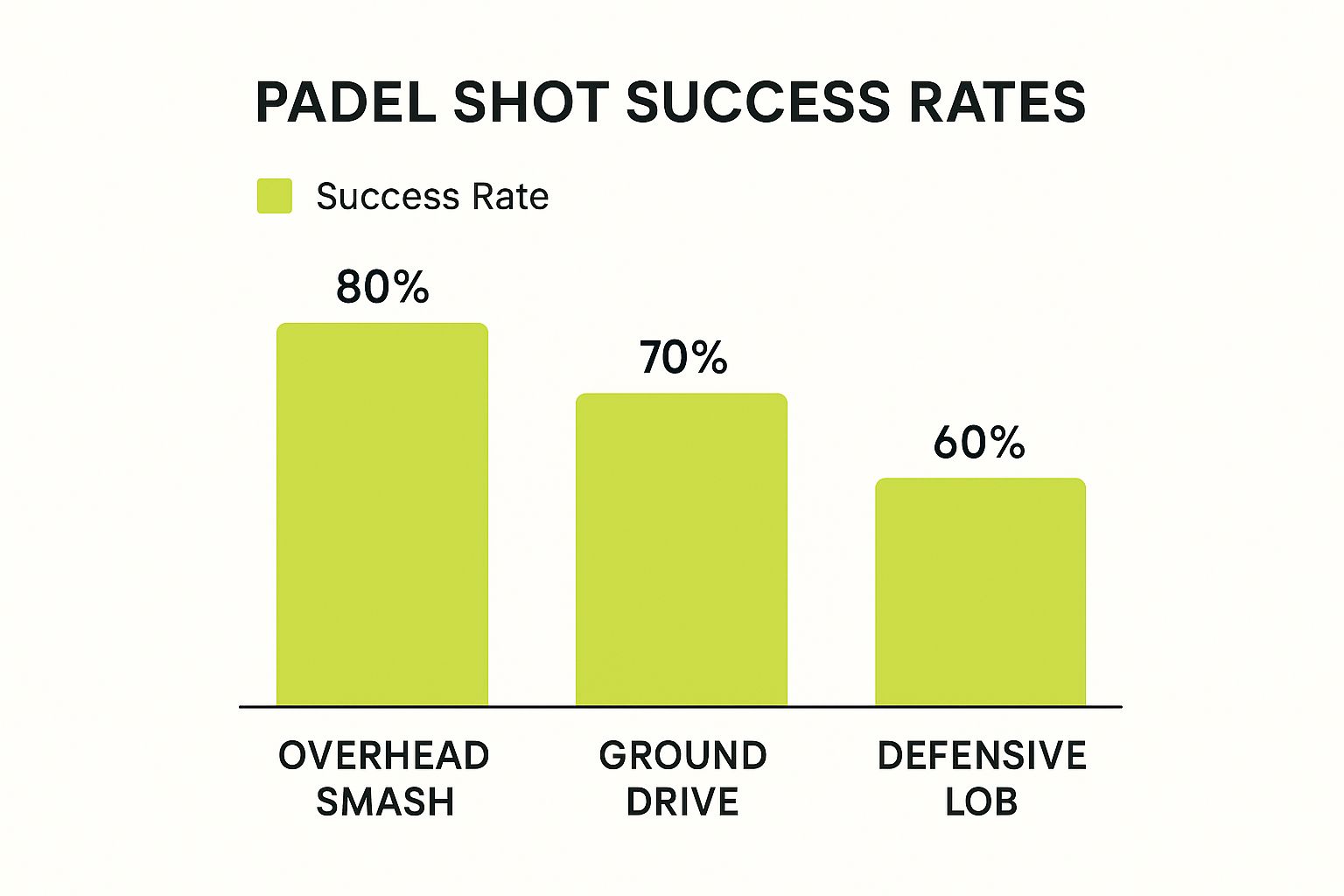
This chart shows just how important a well-rounded game is. While an aggressive smash can win you a point, a well-placed defensive lob is almost as effective. It's all about balance.
Serving Up a Different Game
The serve is another game-changer. In tennis, the overhead serve is a major weapon. In padel? It's strictly underhand. You have to bounce the ball once and hit it at or below your waist.
This simple rule completely changes the dynamic. The serve isn't an attack—it's just a way to start the point. This leads to longer, more exciting rallies right from the get-go.
Padel vs. Tennis: A Head-to-Head Comparison
Let's break down the key distinctions between these two fantastic sports. While they share some DNA, their core gameplay, equipment, and strategy are fundamentally different. This table lays it all out.
| Feature | Padel Tennis | Traditional Tennis |
|---|---|---|
| Court Size | 10m x 20m, enclosed by glass/mesh walls. | 23.77m x 10.97m (for doubles), open court. |
| Racket | Solid, stringless 'pala' with perforations. | Strung racket with a large head size. |
| Serve | Underhand, must be hit at or below waist level. | Overhead, a major offensive weapon. |
| Ball | Slightly smaller and has lower pressure for a slower bounce. | Larger, with higher pressure for a faster, higher bounce. |
| Walls | In play. The ball can be played off the glass walls after one bounce. | Out of play. If the ball hits anything beyond the lines, the point is over. |
| Scoring | Uses the same 15, 30, 40 system as tennis. | The classic 15, 30, 40 system. |
| Game Style | Strategic, cooperative, and social. Emphasis on rallies and placement. | Can be power-oriented, focusing on athletic ability and powerful strokes. |
| Player Format | Almost exclusively played in doubles. | Played in both singles and doubles. |
As you can see, the differences create two unique experiences. Tennis is a fantastic test of individual athleticism, while padel shines as a strategic, team-based sport.
The very essence of padel is teamwork. Since it's played in doubles on a smaller court, communication with your partner isn't just helpful—it's essential. For a deeper look, you can learn more about the subtle but crucial differences between padel and tennis in our complete comparison.
Ultimately, even if you’re a seasoned tennis player, you’ll find success in padel by leaving your old habits behind. Embrace the walls, work with your partner, and get ready for a game that’s as much a mental workout as it is a physical one.
The Social and Physical Benefits of Padel
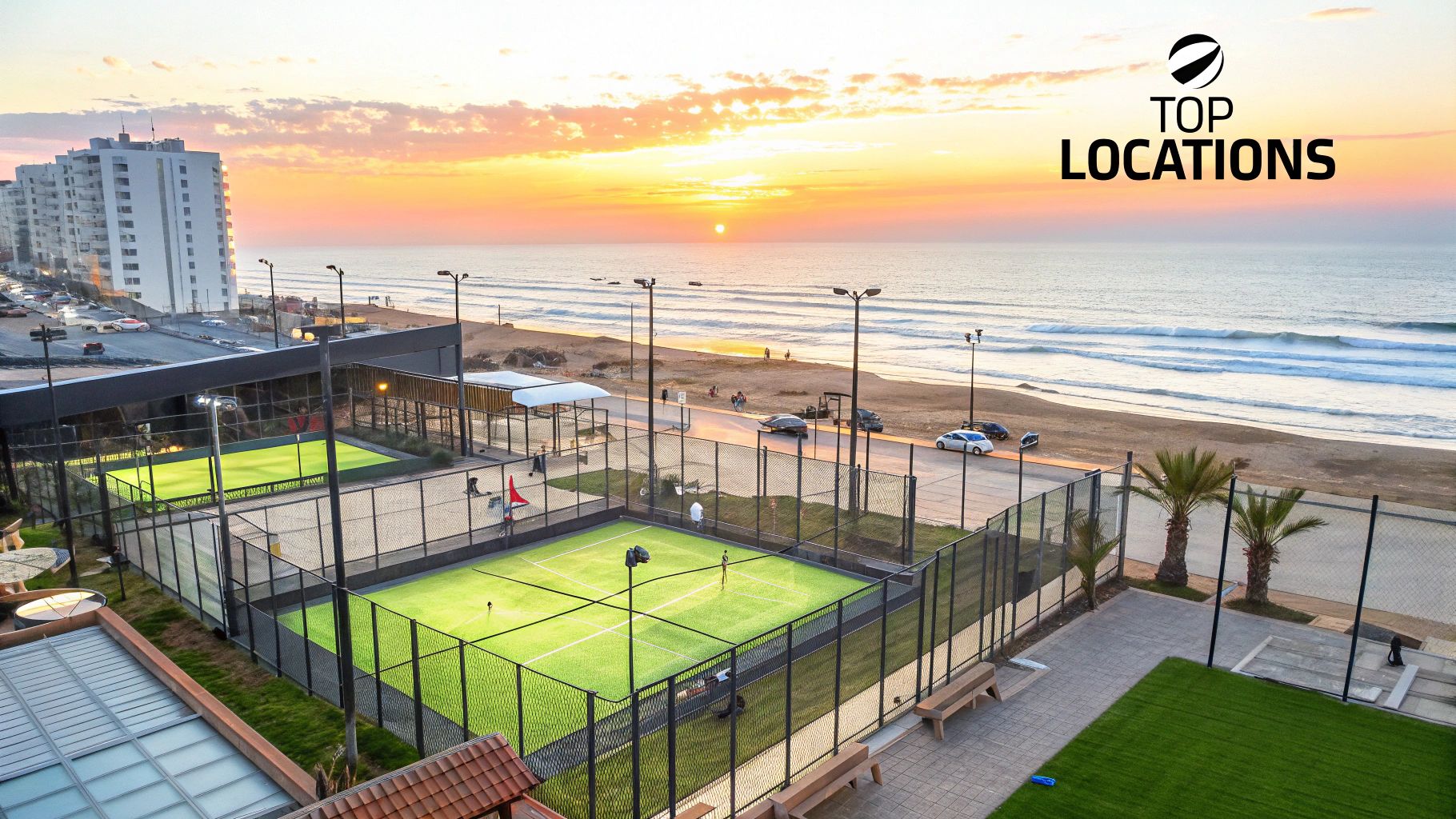
Padel's incredible popularity isn't just about what happens inside the glass walls. It's a game, sure, but it’s also a powerful social and physical experience that builds communities and genuinely boosts your well-being. The sport is almost perfectly designed to forge connections while delivering a fantastic workout that’s both fun and easy on the body.
The first thing new players almost always fall in love with is the social aspect. Padel tennis is almost always played in doubles, which means it’s built around teamwork, communication, and those high-five moments after a great point. You’re constantly chatting with your partner, figuring out strategies, and celebrating victories together, which creates a real sense of camaraderie.
This built-in social dynamic is a huge part of why people get hooked. It flips exercise from a lonely chore into a fun outing with friends. Padel clubs quickly become vibrant hubs where friendships are made both on and off the court.
A Workout for Mind and Body
Padel gives you a dynamic, full-body workout that gets your heart pumping and sharpens your reflexes—all without the punishing impact of other racket sports. The constant movement, quick turns, and short sprints for the ball are great for your cardiovascular health and burn a surprising number of calories.
At the same time, the smaller court and less forceful shots mean you're putting much less strain on your joints, especially your knees and shoulders. This makes padel a sport you can stick with and enjoy for decades.
Padel is a perfect blend of physical activity and mental stimulation. It engages your body in a fun, dynamic way while keeping your mind sharp with strategic challenges, making it an ideal activity for long-term health.
Beyond the physical perks, padel offers a serious mental boost. Every single rally is a fast-paced puzzle. You have to think strategically and make split-second decisions, constantly reading your opponents' positions, trying to guess their next move, and planning your own shot. This mental workout is a fantastic way to sharpen your focus and blow off some steam. To really get the most out of it, consider some professional padel coaching to build your confidence and strategic game.
An Incredibly Inclusive Sport
One of padel's best features is how welcoming it is to everyone. The learning curve is gentle, and the game is less physically demanding than tennis, so people of all ages and fitness levels can jump on a court together and have an absolute blast. It's common to see players from different generations teamed up for a friendly match.
This broad appeal has fueled a diverse global community. The sport is now played by an estimated 30 million people worldwide, and it boasts a fantastic gender balance, with about 40% of players being female. That demographic spread, with players from 18 to 70 years old, really shows how its welcoming vibe has caught on everywhere.
Ultimately, padel offers the complete package. It strengthens your body, challenges your mind, and connects you with a friendly, passionate community.
Common Questions About Padel Tennis
As you gear up to hit the court for the first time, a few practical questions are bound to pop into your head. Nailing down these small details can make a world of difference for your confidence and how much you enjoy the game.
Think of this as your final checklist before you step out for your first match. We’ll cover everything from the number of players to the right gear, making sure you feel totally prepared.
Can I Play Padel as a Singles Game?
While you might stumble across a purpose-built singles court once in a blue moon, padel tennis is overwhelmingly a doubles game. The standard court, the core strategies, and the very soul of the sport are all designed for four players.
It's the smaller court and the teamwork in doubles that makes padel so social and exciting. You can technically play one-on-one, but it’s pretty rare because it completely changes the flow and, frankly, a lot of the fun.
What Kind of Shoes Should I Wear for Padel?
This is a fantastic question, and getting it right is crucial for both your performance and avoiding injury. Padel is full of sharp turns, pivots, and quick sideways movements. Because of this, your everyday running shoes just won't cut it—they don't have the side-to-side stability you desperately need.
For the best and safest experience on the court, you'll want one of two options:
- Padel-Specific Shoes: These are your best bet. They're engineered specifically for the sport's unique demands, giving you the perfect blend of support and grip.
- Clay-Court Tennis Shoes: These are a brilliant alternative. Their herringbone sole pattern provides excellent grip for sudden stops while still allowing you to slide into those tough-to-reach shots.
The most common mistake beginners make is hitting the ball too hard, just like in tennis. Padel is a game of strategy, not overwhelming power. Successful newcomers quickly learn to use the walls, play with control, and focus on placing the ball in tough spots for their opponents. Patience and placement will consistently win more points than pure speed.
Does the Ball Have to Hit the Ground Before the Wall?
Yes, absolutely. This is one of the most important rules in padel and a common point of confusion for players coming from other racquet sports.
The ball must bounce on the ground on your opponent's side once (and only once) before it can be played off any of the glass walls. If you smash the ball directly into your opponent's back wall without it bouncing first, that's a fault. You lose the point. Mastering this sequence is fundamental to understanding the game's unique rhythm.
At Padel Rumors, we're dedicated to helping you fall in love with this amazing sport. From beginner guides to pro news and gear reviews, find everything you need to know at https://www.padelrumors.com.


